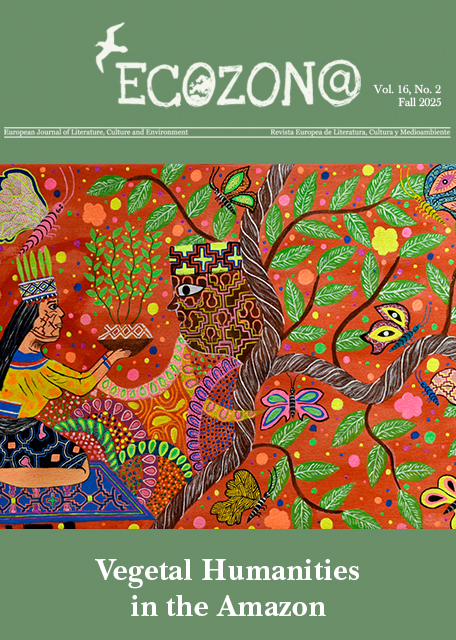<b>Paradise Retold: Revisionist Mythmaking in Margaret Atwood’s <i>MaddAddam Trilogy</i></b> // El paraíso contado de nuevo: La revisión del mito en la <i>Trilogía MaddAddam</i> de Margaret Atwood
DOI:
https://doi.org/10.37536/ECOZONA.2018.9.2.2291Parole chiave:
Myth, paradise, ecocriticism, feminist revision, Margaret Atwood // Mito, paraíso, ecocrítica, revisión feminista, Margaret AtwoodAbstract
This paper focuses on the subversive potential of myths by exploring Margaret Atwood’s feminist revision of creation, more specifically the myth of paradise. According to Adrienne Rich’s definition, the “re-vision” of myths signifies the critical adaptation, appropriation, and invasion of traditional texts. As such, myths have not only legitimized exploitative power relationships, but they have also served as a powerful means to participate in and subvert hegemonic discourses. By drawing on the theories of Aby Warburg, Ernst Cassirer, and Hans Blumenberg, for whom myths constitute cultural-artistic mediations that involve the polarities of affect and intellect, terror and logos, Atwood’s revision of paradise in the MaddAddam trilogy may be approached in itself as – to use a term by Hans Blumenberg – a “work of logos.” I argue that Atwood revises paradise by duplicating the ancient human dreams of paradise into Crake’s techno pagan and Adam One’s eco-millennialist “gardens of delights,” both of which are refracted through evolutionary science and ecology.Characterized by human destructiveness, these posthuman paradises feature multiple Eves alongside the dominant male figures. Among Atwood’s Eves, there is the brazen Oryx as exploited racial “Other” of white society in the pathos formula of the Asian “digital virgin prostitute.” Atwood employs a self-reflexivity regarding myths that is characteristic of postmodern pastiche and thus highlights storytelling as the distinguishing characteristic of humankind, while her use of an evolutionary grotesque aesthetics erodes clear-cut distinctions between humans, animals, and post-humans. The myth of paradise, the trilogy suggests, is also always a myth of extinction.
Resumen
Este artículo se centra en el potencial subversivo de los mitos al explorar la revisión feminista de la creación de Margaret Atwood, más específicamente, el mito del paraíso. Según la definición de Adrienne Rich, la "re-visión" de los mitos significa la adaptación crítica, la apropiación y la invasión de los textos tradicionales. Como tal, los mitos no solo han legitimado las relaciones con poder de explotación, sino que también han servido como un poderoso medio para participar en los discursos hegemónicos y subvertirlos. Al basarse en las teorías de Aby Warburg, Ernst Cassirer y Hans Blumenberg, para quienes los mitos constituyen mediaciones artístico-culturales que involucran las polaridades del afecto y el intelecto, el terror y el logos, la revisión del paraíso de Atwood en la triología MaddAddam se puede abordar en sí misma como (por usar un término de Hans Blumenberg) una "obra de logos". Argumento que Atwood revisa el paraíso al duplicar los antiguos sueños humanos del paraíso en el tecno pagano de Crake y en los "jardines de las delicias" ecomilenialistas de Adam One, ambos refractados a través de la ciencia y la ecología evolutivas. Caracterizados por la destructividad humana, estos paraísos posthumanos presentan múltiples Evas junto a las figuras masculinas dominantes. Entre las Evas de Atwood está el descarado Oryx como el «Otro» racial explotado de la sociedad blanca en la pathos formula de la asiática «prostituta virgen digital». Atwood realiza una autorreflexión sobre los mitos característicos del pastiche posmoderno y destaca la narración de cuentos como la característica distintiva de la humanidad, mientras que su uso de una estética evolutiva grotesca erosiona distinciones muy claras entre humanos, animales y poshumanos. El mito del paraíso, sugiere la trilogía, es siempre un mito de la extinción.
Downloads
##submission.downloads##
##submission.additionalFiles##
Pubblicato
Fascicolo
Sezione
Licenza
Authors who publish with this journal agree to the following terms:
a) Authors retain copyright and grant the journal right of first publication with the work simultaneously licensed under a Creative Commons Attribution License that allows others to share the work with an acknowledgement of the work's authorship and initial publication in this journal (CC BY-NC for articles and CC BY-NC-ND for creative work, unless author requests otherwise.
b) Authors are able to enter into separate, additional contractual arrangements for the non-exclusive distribution of the journal's published version of the work (e.g., post it to an institutional repository or publish it in a book), with an acknowledgement of its initial publication in this journal.
c) Authors are permitted and encouraged to post their work online (e.g., in institutional repositories or on their website) prior to and during the submission process, as it can lead to productive exchanges, as well as earlier and greater citation of published work (See The Effect of Open Access).










